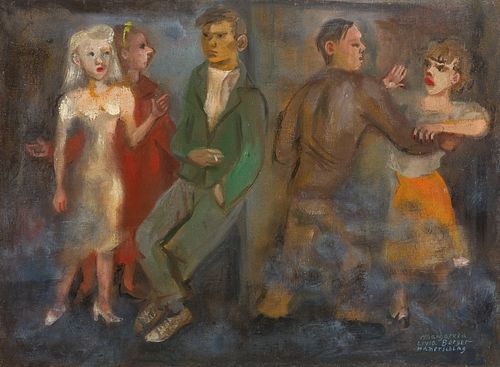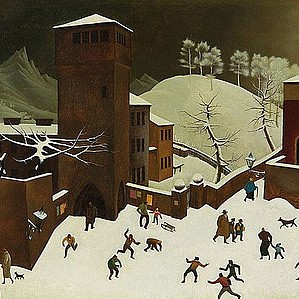MARGARETE BERGER-HAMERSCHLAG (Vienna 1902 - 1958 London) At the Youth Club
Lot 66
Estimate:
EUR€2,500 - EUR€4,000
$2,631.58 - $4,210.53
Absentee vs Live bid
Two ways to bid:
- Leave a max absentee bid and the platform will bid on your behalf up to your maximum bid during the live auction.
- Bid live during the auction and your bids will be submitted real-time to the auctioneer.
Bid Increments
| Price | Bid Increment |
|---|---|
| EUR€0 | EUR€10 |
| EUR€100 | EUR€50 |
| EUR€700 | EUR€100 |
| EUR€1,000 | EUR€200 |
| EUR€3,000 | EUR€300 |
| EUR€3,600 | EUR€400 |
| EUR€4,000 | EUR€500 |
| EUR€7,000 | EUR€1,000 |
| EUR€16,000 | EUR€2,000 |
| EUR€30,000 | EUR€3,000 |
| EUR€36,000 | EUR€4,000 |
| EUR€40,000 | EUR€5,000 |
About Auction
By Widder Auctions
May 19, 2022
Set Reminder
2022-05-19 11:00:00
2022-05-19 11:00:00
America/New_York
Bidsquare
Bidsquare : Masterpieces
https://www.bidsquare.com/auctions/widder-auctions/masterpieces-9287
Masterpieces of classical modernism by Austrian and international artists coming up for auction in Vienna on May 19th Widder Auctions office@widderauktionen.com
Masterpieces of classical modernism by Austrian and international artists coming up for auction in Vienna on May 19th Widder Auctions office@widderauktionen.com
- Lot Description
MARGARETE BERGER-HAMERSCHLAG*
(Vienna 1902 - 1958 London)
At the Youth Club
oil/canvas, 56 x 76 cm
signed Margarete Livia Berger Hamerschlag
Provenance: estate of the artist, Fine Arts Widder Vienna
ESTIMATE °€ 2.500 - 4.000
Austrian painter, author and illustrator of the 20th century. Came from a Jewish family. Attended the youth art class with Franz Cizek from 1910. From 1917 studied at the Kunstgewerbeschule under Bertold Löffler, Oskar Strnad and Eduard Wimmer-Wisgrill. From 1920 illustrations for books of the Wiener Werkstätte, designs for costumes and editorial member of the magazine Wiener Mode. 1922 marriage to the architect and student of Adolfs Loos, Joseph Berger. Lived in the artists' colony on Rosenhügel from 1924 to 1934. Extraordinary member of the Hagenbund. 1927 Participated in the first Viennese women's art exhibition. 1936 Emigration to England. Lived in London as a portraitist, book illustrator and art educator. Created landscapes, still lifes and portraits and, among others, a series of paintings from the Youth Club, where she worked in London.
On the recommendation of Koloman Moser, Margarete Hamerschlag, who came from a middle-class Jewish family, attended art classes with Franz ?ižek at the age of nine. From 1917 to 1922 she studied at the Vienna School of Applied Arts with Oskar Strnad, Eduard Wimmer-Wisgrill and Bertold Löffler. In 1922 she married Josef Berger, architect and student of Adolf Loos. Afterwards she was successful as a book illustrator, painter, watercolorist and woodcut artist as well as a costume designer. The decorative style of the Wiener Werkstätte was soon mixed with grimaces, demons, and figures marked by greed and fear. In 1927 she took part in the first exhibition of women's art in Vienna. Frustrated by the lack of artistic development opportunities and bitterness about the establishment of the Austro-Fascist regime, the couple moved to the British Mandate of Palestine in 1934 because Berger had received a contract to build a hotel in Haifa. For about a year, Berger worked on the hotel plans on the one hand and on the other hand was looking for follow-up orders. Meanwhile, Hamerschlag traveled to Palestine, Syria and Lebanon on his own and recorded his experiences in numerous sketches, paintings and written records. In Haifa, she designed costumes for Yardena Cohen, who would later be considered one of the founders of modern dance in the founding days of Israel. Her work was shown in a gallery in Jerusalem at the time, as well as part of an exhibition of contemporary Austrian art in Košice, Czechoslovakia. In Haifa, the couple, who were Jewish by origin but distanced themselves from religious Judaism, maintained lively contacts with German-speaking immigrants who saw themselves less as Zionist pioneers than as temporary refugees. When tensions between Jews and Arabs in Palestine increased, the Berger-Hamerschlag couple decided to leave the Mandate for England. In December 1935, Hamerschlag traveled by ship from Haifa to London. Berger followed in the following year. After surviving internment in 1940, Berger found a job at the London County Council. Hamerschlag kept in touch with Georg Ehrlich and other emigrants, but also quickly made contact with the English art scene and soon took part in group exhibitions. After the end of the war it called itself Berger-Hamerschlag. She was able to build on her earlier artistic successes and undertook artistically productive journeys, particularly through southern Europe. In addition, she made a name for herself teaching in various London youth clubs. In the youth centre Her work with young people is reflected in a number of pictures as well as in the work in particular depictions of teddy boys, which she also used as illustrations for her most successful publication, "Journey Into A Fog" (1955). With the proceeds from the book, she was able to buy a house in South Hill Park for herself and her family. Two scenes from a youth club are particularly significant with regard to the artist's biography. Both depictions are clearly of a narrative character; the figures are completely related to each other. The older teenagers talk, dance and probably argue with each other without noticing us. The four teenage boys, on the other hand, apparently prefer to be left alone by the adults: the two in front appear as if they were disturbed by us in the game and look suspiciously at the viewer.
PLEASE NOTE:
The purchase price consists of the highest bid plus the buyer's premium, sales tax and, if applicable, the fee of artists resale rights. In the case of normal taxation (marked ° in the catalog), a premium of 24% is added to the highest bid. The mandatory sales tax of 13% is added to the sum of the highest bid and the buyer's premium. The buyer's premium amounts to 28% in case of differential taxation. The sales tax is included in the differential taxation. - Shipping Info
-
Shipping
We will send you the invoice shortly after the auction. As soon as we have recieved the amount, the art can be picked up at Johannesgasse 9-13, 1010 Vienna. Please note that the buyer is responsible for pick-up and shipping of the lot.
Should you wish to ship your items, please contact: Mailboxes Email: oper@mbe-co.at Tel: 01 5128855
Please note that storage fees may apply, should the pieces not be picked up within 14 days after invoicing for domestic and 28 days for international transportation.
Our team will be happy to assist you with any further information at office@widderauktionen.com or at 0043 676 555 66 10.
-
- Buyer's Premium



 EUR
EUR CAD
CAD AUD
AUD GBP
GBP MXN
MXN HKD
HKD CNY
CNY MYR
MYR SEK
SEK SGD
SGD CHF
CHF THB
THB













